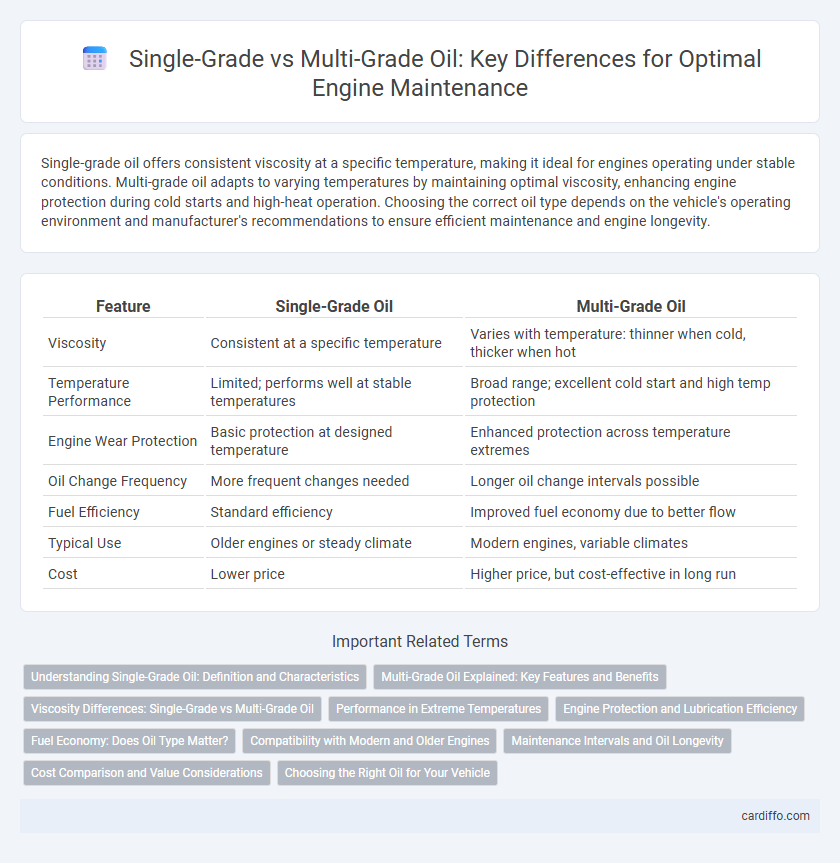Single-grade oil offers consistent viscosity at a specific temperature, making it ideal for engines operating under stable conditions. Multi-grade oil adapts to varying temperatures by maintaining optimal viscosity, enhancing engine protection during cold starts and high-heat operation. Choosing the correct oil type depends on the vehicle's operating environment and manufacturer's recommendations to ensure efficient maintenance and engine longevity.
Table of Comparison
| Feature | Single-Grade Oil | Multi-Grade Oil |
|---|---|---|
| Viscosity | Consistent at a specific temperature | Varies with temperature: thinner when cold, thicker when hot |
| Temperature Performance | Limited; performs well at stable temperatures | Broad range; excellent cold start and high temp protection |
| Engine Wear Protection | Basic protection at designed temperature | Enhanced protection across temperature extremes |
| Oil Change Frequency | More frequent changes needed | Longer oil change intervals possible |
| Fuel Efficiency | Standard efficiency | Improved fuel economy due to better flow |
| Typical Use | Older engines or steady climate | Modern engines, variable climates |
| Cost | Lower price | Higher price, but cost-effective in long run |
Understanding Single-Grade Oil: Definition and Characteristics
Single-grade oil is a lubricant with a consistent viscosity at a specific temperature, designed for use in environments where temperature remains stable. Its molecules maintain uniform thickness, providing reliable lubrication without the complexity of viscosity modifiers found in multi-grade oils. This type of oil is typically used in older engines or machinery that operate under steady conditions, ensuring adequate protection and performance within its designated temperature range.
Multi-Grade Oil Explained: Key Features and Benefits
Multi-grade oil features advanced viscosity modifiers that enable it to perform effectively across a wide temperature range, maintaining optimal lubrication during both cold starts and high operating temperatures. This versatility reduces engine wear, improves fuel efficiency, and extends oil change intervals compared to single-grade oils. Its ability to adapt to temperature fluctuations makes it the preferred choice for modern engines requiring reliable performance in diverse driving conditions.
Viscosity Differences: Single-Grade vs Multi-Grade Oil
Single-grade oil maintains a consistent viscosity at a specific temperature, providing reliable lubrication in stable temperature conditions but potentially thickening in cold or thinning in hot environments. Multi-grade oil features additives that allow it to adapt its viscosity across a wider temperature range, improving engine protection during cold starts and high-temperature operations. This versatility in viscosity performance makes multi-grade oils more effective for modern engines experiencing varying temperature stresses.
Performance in Extreme Temperatures
Single-grade oil maintains consistent viscosity at a specific temperature but can become too thick in cold conditions or thin in extreme heat, reducing engine efficiency. Multi-grade oil contains additives that allow it to perform effectively across a wider temperature range by preventing viscosity breakdown in heat and thickening in cold. This adaptability enhances engine protection and performance during extreme temperature fluctuations, reducing wear and improving fuel economy.
Engine Protection and Lubrication Efficiency
Single-grade oil maintains consistent viscosity at a specific temperature, providing reliable engine protection under stable conditions but limited adaptability across temperature variations. Multi-grade oil adapts its viscosity over a broad temperature range, ensuring optimal lubrication efficiency and enhanced engine protection during cold starts and high-heat operation. Using multi-grade oil reduces engine wear and improves fuel efficiency by maintaining a protective oil film in diverse driving environments.
Fuel Economy: Does Oil Type Matter?
Single-grade oils maintain a consistent viscosity at a specific temperature, which can lead to less efficient engine performance under varying conditions, potentially reducing fuel economy. Multi-grade oils offer adaptable viscosity by combining different oil grades, ensuring optimal lubrication across a wider temperature range and improving engine efficiency. Using multi-grade oil typically enhances fuel economy by reducing engine friction and wear during cold starts and high-temperature operations.
Compatibility with Modern and Older Engines
Single-grade oil maintains consistent viscosity ideal for older engines designed with simpler tolerance specifications, ensuring optimal lubrication at specific temperature ranges. Multi-grade oil features advanced viscosity modifiers that provide superior performance across a broad range of temperatures, making it compatible with modern engines requiring flexible protection. Selecting the correct oil grade enhances engine longevity by matching lubrication properties with engine design and operating conditions.
Maintenance Intervals and Oil Longevity
Single-grade oil offers stable viscosity but requires more frequent oil changes due to faster degradation under varying temperatures, impacting maintenance intervals. Multi-grade oil adapts viscosity across temperature ranges, extending oil longevity and lengthening maintenance intervals. Choosing multi-grade oil reduces the frequency of oil changes, leading to improved engine protection and lower overall maintenance costs.
Cost Comparison and Value Considerations
Single-grade oil typically costs less upfront than multi-grade oil, making it a budget-friendly option for consistent temperature environments, but it may require more frequent changes. Multi-grade oil, though more expensive per quart, offers superior protection across temperature variations, potentially reducing engine wear and maintenance costs over time. Evaluating long-term value, multi-grade oil often provides better overall engine performance and longevity, which can lead to cost savings beyond the initial purchase price.
Choosing the Right Oil for Your Vehicle
Selecting the right oil for your vehicle involves understanding the differences between single-grade and multi-grade oils, with multi-grade oils offering versatility by maintaining stable viscosity across a wide temperature range. Single-grade oils are typically suited for older engines or specific operating conditions requiring consistent viscosity, while multi-grade oils provide enhanced protection for modern engines by adapting to temperature fluctuations. Using the manufacturer-recommended oil grade ensures optimal engine performance, longevity, and fuel efficiency.
Single-Grade Oil vs Multi-Grade Oil Infographic

 cardiffo.com
cardiffo.com